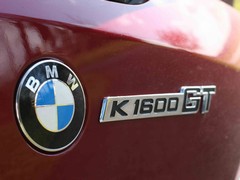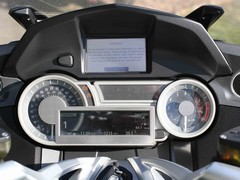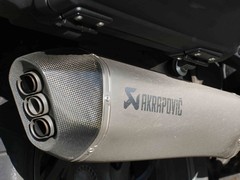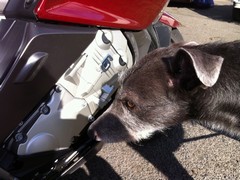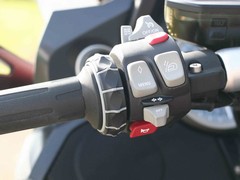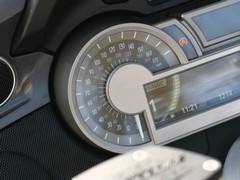PH2: BMW K1600 GT
Can you really have too many cylinders? BMW's uber-tourer thinks not...
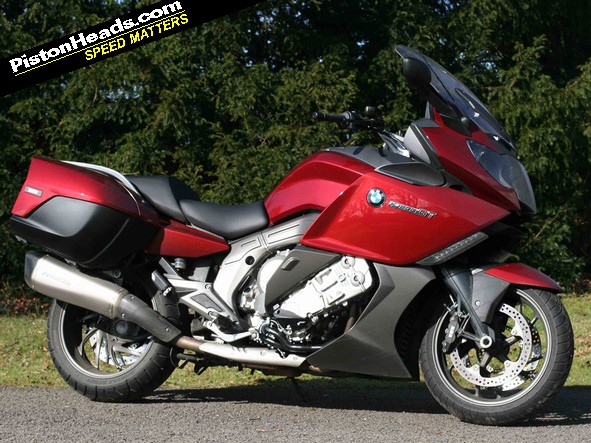
It all boils down to physics. Bikes lean, cars don't. Stick a wide engine on a bike and you start to encounter ground-clearance issues. In the 1970s monsters such as the Honda CBX1100 and Kawasaki Z1300 came with across-the-frame in-line six motors, but they died out in the 1980s when tyre companies discovered grip. Honda only gets away with it on the 'Wing by laying the engine flat, thus making it long rather than wide, with three cylinders per side. BMW changed all this last year by making the K1600, an in-line six that sits in the same direction as most four-pot sports bike motors and is only marginally wider. Which begs the question: why?
The joy of six
The K1600 GT is all about torque, thumping out a massive 112lb ft at 5,250rpm. But this only tells half the story. The peak is at this point, but the GT has more grunt than a 70s porn star and by 1,500rpm it is making around 80lb ft. When you ride a touring bike you want to be lazy, and with this much torque on offer you can be incredibly lazy on the GT - and that's all down to the in-line six motor.
There is virtually no need to change gear on the GT, the engine pulls from everywhere in the rev range and does so with a strong burst of acceleration. Adding a pillion into the equation doesn't seem to affect the motor and it keeps on churning out the torque and powering you on your way. But the biggest surprise is when you hit the top of the rev range.
The bike I rode had a set of aftermarket road legal Akrapovic cans fitted, something that enhanced the truly outstanding sound when the in-line six started to spin. At 6,500rpm the whole engine's note changes and it screams until it hits the 8,500rpm redline. It's bloody wonderful and totally unlike a touring bike. But it's not all plain sailing.
With fewer than 1,500 miles on the clock, the bike I rode was pretty fresh, but all the same the gearbox was fairly rough. The lever's action was clunky and stiff and, while I accept this may ease when the gearbox beds in, I wasn't that impressed. That said, the engine is so good you hardly ever need to shift anyway...
Touring ticked?
A touring bike has to be comfortable. Secondly, it has to have a decent tank range as there is no point in having a comfortable bike that needs filling up every few miles. Thirdly, it has to handle well and, finally, have a motor that doesn't require constant attention. I don't mean servicing attention, I mean needless gear changes every time you want to overtake a car or accelerate out of a restricted limit zone. With all that torque on offer, the BMW certainly ticks this box and the GT averaged 45mpg with a tank range of close to 230 miles, which is certainly acceptable.
On the comfort stakes the BMW's seat is sumptuous and superbly sculpted. The adjustable screen is nicely V-shaped, so that your get a clear view of the road through the bottom of the V while the rest of the screen deflects the wind/rain, and the stretch to the bars is relaxed. In fact I did several journeys of over 140 miles with no discomfort at all on the GT, so top marks there. And the handling is also extremely good.
Yes it's a big old bus, but the GT carries its 319kg extremely well and at low speed is remarkably balanced and easy to control. Through faster bends the weight pins the bike to the road and, for a full dress tourer the BMW is certainly sporty and lacking any of usual wobble of bigger bikes, thanks in part to the excellent electronically adjustable suspension. Push a few buttons and the ESA firms-up the ride, a few more buttons and it is back to soft and forgiving. Ah yes, electronics...
Digital distraction
We have a few moans about the K1600, most of which stem from the sheer number of gizmos on board. The bike we tested had cruise control, heated grips, radio (which can be heard at 80mph!), a heated seat, GPS, active suspension, fuel modes and about a million-and-one other techy bits, most of which are operated via the onboard computer system.
Despite being extremely well thought out and clear, it can be a constant distraction. Trying to turn up the temperature on the heated grips involves scrolling through three or four different screens and you have to wonder just how much of the info available is actually of any use. On a bike you want to know how much fuel you have left, how fast you're going, what gear you're in and that's about it. Annoyingly, the analogue speedo is a bit cluttered and most of the time it's easier to read your speed from the GPS display!
Further ergonomic moans relate to the imprecise indicator switch, which owners will probably adapt to, but the location of the horn is much more of a worry. Horns are quite useful and on the GT, I found the rotating controller for the onboard computer got in the way of getting to the horn button. The one time I needed to toot at a car I instead found myself changing the tune on my iPod (yep, that links in as well) and blasting Staying Alive at the offending car by way of a warning...
Verdict
For destroying the miles the GT is superb. It's extremely comfortable, rapid and can even corner with some degree of sporting ability. The electronics are annoying, but that's just the way things are going. If you want all the bells and whistles you need some way to control them and it's better through one screen than to have a million buttons like a packet of spilt M&Ms on the dash. At £15K without all the gizmos the GT ain't cheap, but it is also one hell of an impressive bike.
Engine: 1,649cc, six-cylinder
Power: 130hp at 7,800rpm
Torque: 113lb ft at 5,200 lb ft
Top Speed: 140mph (est)
Weight: 319kg (wet)
MPG: 45mpg (tested)
Price: £15,495
Gassing Station | Biker Banter | Top of Page | What's New | My Stuff

